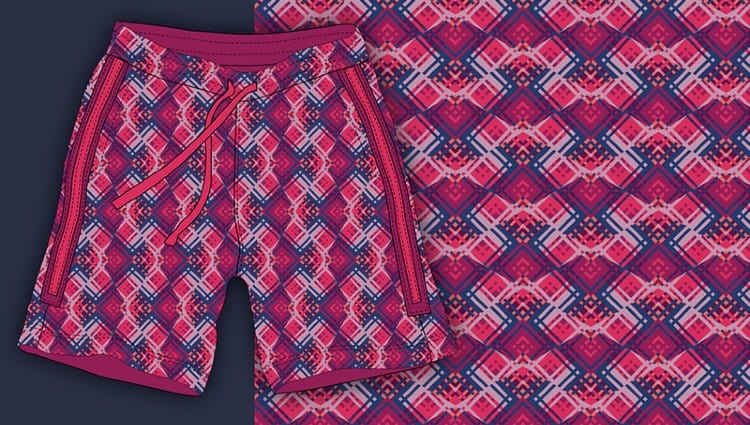Swimming is a great way of getting fit and having fun at the same time. If you haven’t been for a swim lately, now is the perfect time to start thinking about new swimwear. There are so many fabric choices, though. How do you know which one to go for? What is the best fabric for swimwear?
The best fabric for swimwear is a polyester/elastane blend. Elastane is the super stretchy fabric better known by the brand names Spandex or Lycra. Polyester is colorfast and resistant to chlorine, making it a perfect choice. Nylon is another good fabric for swimwear, but it is more likely to pill over time.
Swimwear fabric has to be comfortable and durable. When combined with elastane, polyester and nylon have similar qualities. Let’s take a look at how each one performs in swimwear.

What Material Are Swimsuits Made Of?
Natural Fabrics
Before the invention of synthetic fibers or stretchy Lycra, swimsuits were made from natural fibers. Weirdly enough, wool was one of the most popular. The thinking behind the use of wool, it has a certain amount of elasticity, so it could be knitted into close-fitting swimwear.
Wool was also readily available and affordable, meaning swimmers could knit their swimming costumes. There were knitting patterns in fashion magazines to enable them to do this. Slightly bizarre from a modern-day perspective, but it was all they had back in the days before Spandex and Lycra. One of the leading names in swimwear today, Speedo, started as a knitting factory making socks.
Like most natural fibers, wool tends to soak up water. This causes it to expand, become heavy and stretch out of shape. None of which are endearing qualities when it comes to bathing suits.
With the recent push for more sustainable options, wool and polycotton blends are slowly making their way back into swimwear. There’s still a long way to go before natural fabrics can come close to the superior swimming experience offered by synthetic materials. Until then, natural fibers will continue to be ruled out when choosing suitable fabrics for swimwear.
The change from natural to synthetic fibers is all down to the introduction of Lycra back in the 1950s. Swim-orientated garment design was revolutionized. Leading to groundbreaking progress in the development of swimwear.
Synthetic Fabrics
The list of synthetic fibers and blends of fibers is endless for suitable fabrics for swimwear. Synthetic materials are brimming with the essential qualities today’s swimwear needs to perform in both competitive sports and fashion arenas.
Topping the choice of suitable fabrics is polyester. A fabric with built-in resistance to chlorine and sunlight, it’s both easy to care for and durable. When blended with the stretch of elastane, the inherent qualities of polyester make it the perfect option for swimwear.
There are different combinations of polyester-elastane blends. Some fabrics will contain more polyester, others more elastane. The result is the same, though. A fully functional, resilient piece of clothing designed to be a hit in the pool or by the beach.
Elastane can be blended with other fabrics besides polyester. Going by the names Spandex or Lycra, elastane can be coupled with nylon to create a swimwear fabric. Nylon is less UV resistant and can be damaged by chlorine. It’s still a suitable alternative to a polyester-based garment, especially if you are looking for a one-season fashion swimsuit.
Less popular but just as comfortable is a polycotton-spandex knit fabric. This option combines the look and feel of polycotton with the stretch needed for swimwear.
It comes with some disadvantages. Being part-natural fiber affects its ability to dry quickly and it tends to fade at a faster rate. Despite this and depending on the ratio of polyester to cotton, this fabric has the potential to be a durable and viable choice.
Best Swimsuit Materials
Polyester
 Soft fabric with incredible durability, polyester is one of the most popular fabrics in apparel construction.
Soft fabric with incredible durability, polyester is one of the most popular fabrics in apparel construction.
Its quick-drying properties and longevity make it a great choice for swimwear, especially for competitive swimming.
With built-in UV resistance and the ability to withstand regular contact with chlorine, this fabric is a top choice for any garment likely to be used on the beach or by the pool.
| Pros | Cons |
|
|
Nylon
 Also known as Polyamide, nylon is quick-drying and water-resistant. Found primarily in fashion swimwear, it is incredibly comfortable and flattering to wear.
Also known as Polyamide, nylon is quick-drying and water-resistant. Found primarily in fashion swimwear, it is incredibly comfortable and flattering to wear.
Soft with a slightly glossy sheen, the fabric looks and feels attractive.
When mixed with elastane, the fabric can be figure-hugging, which can help hide body fullness.
Because of this, it has become a popular material for swimming costumes, pools, and beachwear.
| Pros | Cons |
|
|
Elastane
 Elastane was developed for apparel use in the late 1950s. It’s the generic name for the elastic fabric found in brands like Lycra and Spandex. A 100% synthetic material, elastane is polyurethane.
Elastane was developed for apparel use in the late 1950s. It’s the generic name for the elastic fabric found in brands like Lycra and Spandex. A 100% synthetic material, elastane is polyurethane.
Originally introduced to replace rubber, it also has a wide range of industrial applications, including shock and heat insulation.
Elastane can be used with synthetic materials or added to natural fibers to give garments a comfortable stretch. Its elastic properties make it an ideal fabric for swimwear.| Pros | Cons |
|
|
PBT
 PBT for shortPolybutylene Terephthalate, or PBT for short, is a plastic yarn fiber with natural stretch and recovery. PBT is a member of the polyester family of plastics.
PBT for shortPolybutylene Terephthalate, or PBT for short, is a plastic yarn fiber with natural stretch and recovery. PBT is a member of the polyester family of plastics.
Not as stretchy as other polyesters, its texture is stiffer with a light and smooth feel.
Coupled with the slightly duller or matte finish, the material glides through the water. An attribute making it fantastic for competitive sportswear.
| Pros | Cons |
|
|
Cotton
 Historically natural fibers like wool or cotton would have been used to make bathing costumes. Think Victorian beach-goers with their full body-covering outfits. One of the main problems with natural fibers is water retention. Clothing can absorb too much water causing the swimmer to sink. Or worse, lose their swimsuit as it pulls out of shape and falls off.
Historically natural fibers like wool or cotton would have been used to make bathing costumes. Think Victorian beach-goers with their full body-covering outfits. One of the main problems with natural fibers is water retention. Clothing can absorb too much water causing the swimmer to sink. Or worse, lose their swimsuit as it pulls out of shape and falls off.
These days, cotton and bamboo are used to create retro swimwear reminiscent of by-gone days. These outfits are not designed for regular or competitive swimming, they’re more for beach-lounging or relaxing on a deck-chair.
| Pros | Cons |
|
|
What Other Fabrics Can Be Used in Swimwear?

Several activities require swimwear, including scuba diving and swimming. Swimsuits are also used away from the water in sunbathing, beach volleyball, body-building, and beauty contests. Let’s take a look at some other fabrics associated with fun both in and out of the water.
Neoprene
Neoprene is a synthetic rubber and not technically a fabric. Used for wetsuits, neoprene is the inner layer of insulating foam, keeping divers and surfers warm. Particularly in winter or in seas known to be chilly all year round.
The reason they are called wetsuits is that water is trapped close to the skin. As body heat warms the water, the diver’s body temperature is kept at a comfortable level. One disadvantage with neoprene, the divers’ bodies are always wet.
As a swimsuit material, this constant wetness near the body can be an issue. In warm weather, the trapped warm air can cause overheating. The material can be uncomfortable to wear and difficult to get on and off. Many surfers and divers tend to wear a swimming costume underneath their wetsuits to prevent them from sticking to their skin.
Scuba Fabric
Sometimes confused with neoprene, scuba fabric is double-knit with lots of stretch. Like a Ponte knit in construction, the fabric is quite stiff and used to create structure in garments. Although it lacks the inner layer of insulating foam, scuba’s overall look and feel is the same as neoprene.
Not being as flexible as a polyester-spandex mix, your scuba suit might restrict movement in activities like volleyball. But, if a structured wetsuit look is one you are looking for in your swimwear, scuba is the choice for you. Durable, resilient, and fully opaque, it’s a great choice for both style and modesty.
Swimwear Lining Fabric
Some swimwear fabrics can sometimes be a little transparent, particularly when they get wet. For this reason, you’ll find a lining is an essential addition. Not only that, but a lining can also make the swimsuit more comfortable to wear.
When choosing a fabric for your lining, make sure to pick one with similar properties to your swimsuit material. You need the lining to behave and move in the same way. Ensure it is colorfast, chlorine-resistant, and durable.
An ideal fabric for swimwear lining used a lot in commercial garments is power mesh. This fabric is perfect for body control. When cut a little smaller than the swimsuit, it can help to camouflage lumpy love handles.
What to Consider When Looking For Swimwear Fabric?

The last thing you need in a swimwear fabric is for your bikini or swimming shorts to turn see-through underwater. A fabric that shrinks when wet can also cause a few embarrassing problems.
Choosing a suitable material for swimwear is essential for both modesty and comfort. Here’s a list of characteristics your chosen fabric needs to have to be suitable for swimming costumes.
Weight
One thing you don’t want in a swimwear fabric is anything too heavy. Lighter fabrics will look and feel like comfortable underwear. Most swim-quality material is made from lightweight synthetic fabrics. An ideal weight would be between 180-200g per square meter of material.
Look and Feel
Swimwear fabric needs to look good and help you feel confident. It should be soft, flexible, and have an attractive design or print. Let’s face it, most modern-day swimsuits leave little to the imagination. What’s on show needs to look fantastic, so you don’t feel anxious wearing the garment. The fabric should enhance your assets, not detract from them. Avoid neon colors if you are at all body-conscious.
Comfort
An uncomfortable swimming costume is going to severely hamper your enjoyment. As well as your freedom of movement. A swimwear fabric needs to be flexible enough to allow your body to move. It also needs to be soft enough to prevent rubbing and chaffing. When it comes to swimwear, the softer the material, the better.
Figure-Flattering
Everyone likes to look good at the beach or the side of the pool. Today’s swimwear fabrics contain elastane, which is figure-hugging. Able to control and contain those areas of our bodies we’d all rather hide, the best swimwear material will make us look thinner with more of an athletic silhouette.
Fiber Content
When it comes to swimwear, the best fiber content for your fabric is a stretchy synthetic. Created by blending either polyester or nylon with elastane, swimwear fabrics are naturally durable, water-resistant, and quick-drying. A polyester/elastane mix will also give protection from UV rays and be resistant to chlorine.
Colorfast
The last thing you need is the color from your swimsuit coming out in the pool. Ensure your fabric is colorfast before diving into the deep end. Materials known to fare badly when it comes to color retention include nylon. Not only does it fade quickly, but any printing or ink on the material is also likely to bleed into the water. If you want a logo on your swimming shorts, play it safe and stick to polyester-based fabrics.
Quick-Drying
Particularly important, if you will be taking the plunge daily, you need a material to be quick-drying. There’s nothing worse than having to carry a soggy swimsuit around with you after your morning swim. Most synthetic fibers have a water-resistant quality making them ideal for regular-use swimwear. They’ll not only dry quickly but can also be rinsed out, dried, and ready for your next trip to the pool in no time.
Stretch
Swimsuits are designed to be close-fitting. The closer the fit, the less likely they’ll accidentally fall off underwater. To be figure-hugging, the fabric has to be flexible and stretchy. A lot of swimwear is made with negative ease, meaning there isn’t much space available when you’re wearing it. Make sure your fabric has the necessary stretch to accommodate both you and your need to breathe. Try to find fabric with a four-way stretch with at least a 60-70% stretch in any direction.
Durability
Swimwear fabric needs to be durable and resilient. It comes into contact with pool chemicals and UV rays, and both can cause degradation. A key element for any fabric used in swimsuits is the ability to resist damage caused by chlorine, sunshine, and other abrasive substances like sea salt.
Anti-Pilling
For a long-lasting, durable swimsuit, try to pick a fabric that contains anti-pilling properties. Nylon is known to pill over time as it lacks resistance to chlorine damage. The best fabric for resilience to harsh chemicals is polyester. If anti-pilling is important to you, choose a material with polyester content.
Ease Of Care
Any time you have a fabric coming into regular contact with harmful chemicals like chlorine, you need to wash it. The great thing about synthetic fibers is they are easy to care for. A quick dip in a cool wash, followed by a drip-dry, is all it takes to get the smell of bleach out of your swimwear. So make sure your swimming fabric has a wash-and-go element built-in.
Sustainability
This is a hard box to tick when it comes to swimwear. The best fabrics are synthetics due to the resilience, durability, and flexibility inherent in the material. Unfortunately, synthetics are also the least sustainable of all fibers. Many are petroleum-based and rely heavily on fossil fuels. All is not lost, though. By considering recycled materials, you can go a long way to counteracting the environmental impact of your swimsuit.
Cost
Fabric for swimwear can vary in price. From the inexpensive polyester-based materials to the slightly higher cost of a nylon garment, the choice is down to your budget. The ideal fabric for your swimwear should be the best quality you can afford. Ensure the material has longevity and the investment you make in your swimsuit will repay you with a garment that will still look good after multiple swims.
How Much Fabric Is Needed for a Swimsuit?
The amount of fabric needed for a swimsuit depends on the style of suit you are making. There are a couple of things to consider when calculating material amounts. Do you want to line your swimwear and do you want a full suit or a two-piece bikini? For this example, let’s make a bikini.
Commercial swimwear is made with negative ease, meaning it’s cut smaller than your measurements. This creates the tight-fitting, figure-hugging silhouette swimwear is known for. As a rule of thumb, it’s normal for an amount of up to 2 inches to be deducted from your size. This figure will change depending on how tight you want your bikini.
The next thing to do is measure your bust and hips and decide how much coverage you want. Do you want a low-cut top with tankini briefs? Or full bust coverage and low cut briefs?
The actual fabric needed will be determined by your measurements but between ½ to ¾ of a yard in a 60-inch wide fabric should be ample. Remember to purchase the same amount for your lining!
How Much Fabric for a Bathing Suit?
When thinking of bathing suits, the one-piece swimsuit springs to mind. Because more of the body is covered, fabric needs for this option will be slightly higher than for bikinis, tankinis, and briefs.
Bathing suits or one-piece swimsuits are made with negative ease. Measurements for the one-piece option will need to include coverage for your stomach and back. A yard of fabric measuring 60-inches wide should give you enough material for an all-in-one bathing suit.
Conclusion
The best fabric for swimwear is a stretchy synthetic with chlorine and UV resistance. Knowing what to look for will help you choose your fabric with greater confidence.
Let me know in the comments if you liked the article. Has it helped you pick the best fabric for your next swimsuit? Have you already made a swimming costume using one of the fabrics mentioned? How did you get on?